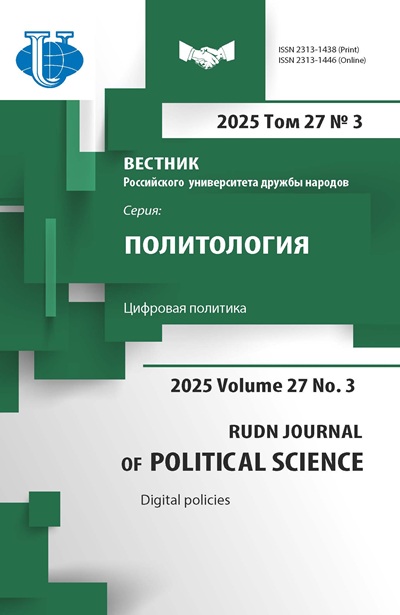Transversality of Network Communications and the Choice of Behavior Strategy: Conceptual Dimension
- Autores: Smorgunov L.V.1
-
Afiliações:
- Sociological Institute of the RAS - Branch of the Federal Center of Theoretical and Applied Sociology of the RAS
- Edição: Volume 27, Nº 3 (2025): Digital policies
- Páginas: 417-429
- Seção: POLITICS ONLINE
- URL: https://journal-vniispk.ru/2313-1438/article/view/348827
- DOI: https://doi.org/10.22363/2313-1438-2025-27-3-417-429
- EDN: https://elibrary.ru/JFKCLB
- ID: 348827
Citar
Resumo
The academic discourse examines how the specific features and attributes of network communication facilitate transversality in interactive exchanges. Scholars particularly emphasize two key phenomena emerging from networked communication: individuation (the personalization of participation) and network solidarity (collective identity formation). These dual phenomena develop within a communicative space characterized by cooperation, instrumental functionality, shared belonging, visual representation, personalization, and motivational stimulation. A central focus lies in how network communication achieves transversality through what we might term a “politics of difference” - the strategic intersection of diverse perspectives. This transversality manifests through several dynamic qualities: the contextual fluidity of communication processes, their inherent multidimensionality, the strategic adaptability of messages, critical receptiveness to opposing views, self-referential meaning-making, pragmatic interaction patterns, and permeability to institutional influences. Together, these characteristics fundamentally reshape behavioral strategy selection models. Where traditional public choice theory operates on causal logic, communicative transversality shifts strategic priorities toward: precautionary approaches (focusing on effects rather than root causes), trust-building through cooperation, and maximizing latent interaction potential.
Sobre autores
Leonid Smorgunov
Sociological Institute of the RAS - Branch of the Federal Center of Theoretical and Applied Sociology of the RAS
Autor responsável pela correspondência
Email: lvsmorgunov@gmail.com
ORCID ID: 0000-0002-2581-2975
Dr. Sci. (Philosophy), Senior Research Fellow
St Petersburg, Russian FederationBibliografia
- Agustín, Ó.G., & Bak, J.M. (2021). On transversal solidarity: An approach to migration and multi-scalar solidarities. Critical Sociology, 47(6), 857–873. http://doi.org/10.1177/0896920520980053 EDN: MZYDAA
- Alekseeva, T.A., & Verkhovskaya, Z.A. (2023). The “third generation” constructivism: Framing and communication. RUDN Journal of Political Science, 25(4), 801–816. (In Russian). http://doi.org/10.22363/2313-1438-2023-25-4-801-816 EDN: QKUFPR
- Bennett, W.L., Segerberg, A. (2012). The logic of connective action. Information, Communication & Society, 15(5), 739–768. http://doi.org/10.1017/CBO9781139198752
- Bohman, J. (2004). Expanding dialogue: The Internet, the public sphere and prospects for transnational democracy. Sociological Review, 52(1), 131–155. http://doi.org/10.1111/j.1467-954X.2004.00477.x EDN: FLMUXH
- Caraway, B. (2016). OUR Walmart: A case study of connective action. Information, Communication & Society, 19(7), 907–920. http://doi.org/10.1080/1369118X.2015.1064464
- Castells, M. (2010). The rise of the network society. 2nd ed. Malden: Blackwell Publishing.
- Castoriadis, C. (1998). The imaginary institution of society. K. Blamey (Trans.). Cambridge, Mass.: The MIT Press.
- Christensen, P.V. (2005). Until further notice: Post-modernity and socio-territorial belonging. International Review of Sociology, 15(3), 553–554. http://doi.org/10.1080/03906700500272566
- Eriksson, K. (2005). On the ontology of networks. Communication and Critical Cultural Studies, 2(4), 305–323. http://doi.org/10.1080/14791420500332451
- Fuller, S. (2021). Post-truth: Knowledge as a struggle for power. Moscow: High School of Economics Publishing.
- Hall, S. (2013). The politics of belonging. Identities: Global studies in culture and power, 20(1), 46–53. http://doi.org/10.1080/1070289X.2012.752371
- Jung, Y. (2009). Transversality and the philosophical politics of multiculturalism in the age of globalization. Research in Phenomenology, 39(3), 416–437. http://doi.org/10.1163/008555509X12472022364208
- Kanngieser, A. (2012). And … and … and … The transversal politics of performative encounters. Deleuze Studies, 6(2), 265–291. http://doi.org/10.3366/dls.2012.0062
- Latour, B. (2005). Reassembling the Social. An Introduction to Actor-Network-Theory. NY: Oxford University Press. http://doi.org/10.1093/oso/9780199256044.001.0001
- Mikhaylenok, O.M., & Nazarenko, A.V. (2020). Network communities: Past and future. Tomsk State University Journal of Philosophy, Sociology and Political Science. 56, 274–284. (In Russian). http://doi.org/10.17223/1998863Х/56/24 EDN: OQJLGI
- Semetsky, I. (2008). The transversal communication, or: Reconciling science and magic. Cybernetics And Human Knowing, 15(2),33–48.
- Simondon, G. (2022). L’individu et sa genèse physico-biologique. Moscow: IOI. (In Russian).
- Smorgunov, L.V. (2021). Digitalization and network effectiveness of public governability. Political Science (RU), 3, 13–36. (In Russian). http://doi.org/10.31249/poln/2021.03.01 EDN: KHMUCH
- Stukal, D.K., Akhremenko, A.S., & Petrov, A.P. (2022). Affective political polarization and hate speech: Made for each other? RUDN Journal of Political Science, 24(3), 480–498. (In Russian). https://doi.org/10.22363/2313-1438-2022-24-3-480-498 EDN: VLTQRN
- Yuval-Davis, N. (2011). Power, intersectionality and the politics of belonging. FREIA Working Paper Series, 75, 1–22. http://doi.org/10.5278/freia.58024502
Arquivos suplementares








